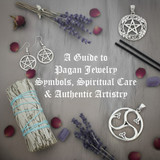The Pendulum Unlock the Answers Within: A Guide to Divination with a Pendulum
Unlock the Answers Within: A Guide to Divination with a Pendulum
Have you ever wished for a simple yet profound way to tap into your intuition and receive clear guidance? The divination pendulum, a seemingly humble tool, holds the key to unlocking a world of yes or no answers. For centuries, this weighted object suspended by a chain or string has served as a conduit between our conscious minds and the deeper wisdom of the universe . It acts as a bridge, translating subtle energetic shifts into visible movements that can illuminate your path and provide clarity in moments of uncertainty . Whether you're a curious newcomer to the mystical arts or a seasoned seeker looking for an accessible divination method, this guide will walk you through the enchanting process of using a pendulum for straightforward answers. Prepare to discover the magic that swings within!
A Journey Through Time: The History and Origins of Pendulums
The practice of using pendulums is far from new; its roots stretch back to the mists of antiquity, where various cultures recognized the power of a swinging object to reveal hidden truths . Ancient civilizations, including those in Egypt and China, employed weighted strings in religious rituals and as a means to divine the future, demonstrating an early understanding of their potential for spiritual inquiry. In ancient Egypt, for instance, pendulums were believed to facilitate communication with the divine during religious rites. Similarly, in ancient China, they were utilized in geomancy, a practice involving the interpretation of earth's energies, to determine auspicious locations for various purposes.
Moving through history, the Middle Ages and Renaissance saw the rise of "dowsing" in Europe, a related practice often employing rods – elongated pendulums – to locate minerals, metals, and even hidden treasures. Over time, the application of these tools expanded beyond practical uses to encompass personal and spiritual questions, highlighting a growing recognition of their capacity to provide guidance on a more intimate level . The term "dowsing" itself refers to the use of a pendulum or rod to gain insight, and while it can be associated with locating physical resources like water, the focus here is on its application as a divination tool for receiving yes or no answers . This rich history underscores a long-standing human fascination with seeking answers beyond the readily apparent, positioning the pendulum as a time-honored instrument for connecting with deeper realms of knowledge
Finding Your Perfect Match: Types of Divination Pendulums
Today, those drawn to pendulum divination have a delightful array of options to choose from. Pendulums are crafted from a variety of materials, each believed to resonate with different energies and intentions. Among the most popular are crystal pendulums, prized for the unique energetic properties inherent in different stones. Clear quartz, often called the "master healer," is favored for its clarity and ability to amplify energy, making it a versatile choice for beginners. Amethyst, with its soothing purple hues, is associated with intuition and spiritual connection, aiding in accessing deeper insights. Rose quartz, known for its gentle pink energy, is often chosen for questions related to love and emotional well-being, infusing readings with compassion. The unique vibrations of each crystal can subtly influence the pendulum's response, allowing you to select a stone that aligns with your specific needs and inquiries. Ultimately, the best pendulum for you is the one that resonates with you on a personal level. Trust your intuition and choose the pendulum that feels right in your hand and speaks to your spirit.
Establishing Your Dialogue: Defining "Yes," "No," and "Maybe"
Before you begin asking questions, it's crucial to establish a clear understanding of how your pendulum will communicate "yes," "no," and potentially "maybe" answers . This process, often called calibrating or programming your pendulum, creates a personal language between you and your tool.
To begin, hold your cleansed and charged pendulum gently by the chain or cord between your thumb and forefinger, allowing it to hang freely . Keep your hand as still as possible. Ask aloud or mentally, "Pendulum, please show me a 'yes' response" . Observe the direction in which the pendulum begins to swing. For many, a "yes" response manifests as a back-and-forth swing directly towards and away from you, or a clockwise circular motion . Remember this movement.
Next, ask, "Pendulum, please show me a 'no' response." The pendulum should now swing in a different direction. Often, a "no" response is indicated by a side-to-side swing, perpendicular to your body, or a counterclockwise circular motion . Take note of this movement as well.
You can also establish a response for "maybe" or "unsure" by asking, "Pendulum, please show me an 'unsure' response." This might manifest as a diagonal swing, a very small or erratic movement, or even stillness . It's important to remember that the specific movements can vary from person to person and even between different pendulums. The key is to establish a clear understanding of your pendulum's unique way of communicating.
The Art of Inquiry: Formulating Effective Questions
To receive clear and reliable answers from your pendulum, the way you formulate your questions is paramount . Your questions should be clear, concise, and specific, allowing for a definitive "yes" or "no" response . For instance, instead of asking an open-ended question like "What will happen to me?", try framing it as a yes or no question such as "Will I receive good news this week?".
It's generally best to avoid ambiguous, overly complex, or leading questions . Leading questions, which subtly suggest a desired answer, can unintentionally influence the pendulum's movement . For example, instead of asking "Shouldn't I take this new job?", a more neutral approach would be "Is taking this new job in my best interest?".
Practice framing your inquiries in a way that allows for a straightforward "yes" or "no" answer. Starting with simple questions where you already know the answer can be a helpful way to build confidence and familiarize yourself with your pendulum's responses. This practice helps to solidify your understanding of its movements and strengthens your connection with the tool.
Connecting with Your Tool: Proper Holding and Positioning
The way you hold and position your pendulum can influence the clarity of your readings. Hold the chain or cord gently between your thumb and forefinger of your dominant hand . Allow the pendulum to hang freely, ensuring your grip is relaxed but secure. Keeping your hand and arm as still as possible is crucial to avoid unintentionally influencing the pendulum's movement. Resting your elbow on a table or another stable surface can provide added support and minimize unwanted movement.
Find a comfortable and focused position where you can relax and allow your energy to flow freely. Ensure you are not tense or fidgeting, as any subtle movements in your hand can affect the pendulum's swing. Creating a calm and centered state will help you to connect more effectively with your intuition and receive clearer responses.
Decoding the Language of Movement: Interpreting Swings
Once you've established your pendulum's responses and are holding it correctly, you can begin to ask your questions and interpret the movements. As you recall, a clockwise or back-and-forth swing often indicates a "yes" answer, while a counterclockwise or side-to-side swing typically signifies "no" . Circular or elliptical movements may suggest a "maybe" or indicate that the question needs to be rephrased for more clarity. Stillness or erratic movement can also sometimes point to an unclear question or an answer that is not yet available.
It's important to remember that the interpretations you established during your initial calibration are the most relevant for your specific pendulum. Pay attention not only to the direction of the swing but also to its strength and consistency. Sometimes, a stronger or wider swing might indicate a more emphatic "yes" or "no," while a weaker swing could suggest a less certain response . As you continue to practice, you may also begin to develop your own intuitive understanding of the nuances in your pendulum's movements . Trust your gut feelings and allow your personal connection with the pendulum to guide your interpretation.
Enhancing Your Connection: Tips for Accurate and Reliable Answers
To enhance the accuracy and reliability of your pendulum readings, consider incorporating these helpful tips into your practice. Begin by creating a calm and quiet environment where you can focus without distractions. Before each session, take a few deep breaths or engage in a brief meditation to ground yourself and clear your mind. Patience is key, especially when you are first starting out. Don't be discouraged if you don't receive clear answers immediately; consistent practice will help you develop a stronger connection with your pendulum.
Approach each session with a clear intention and an open mind, striving to detach from any preconceived notions or desired outcomes that might unconsciously influence the pendulum's movements. Remember that the pendulum acts as a tool to help you access your own inner wisdom and intuition. Avoid using your pendulum when you are feeling overly tired, emotionally charged, or under the influence of substances, as these states can affect the clarity of the reading.
As you become more comfortable with pendulum divination, you might consider using a pendulum board for your inquiries. A pendulum board typically features words, letters, numbers, or symbols arranged on a surface, allowing the pendulum to swing towards specific responses.
Embracing the Guidance of the Pendulum
The divination pendulum offers a simple yet powerful gateway to your intuition and the wisdom of the universe. As a beginner-friendly tool, it empowers you to seek clarity and guidance on a multitude of questions with straightforward yes or no answers. By understanding its history, choosing a pendulum that resonates with you, preparing it with cleansing and charging, establishing clear communication, and practicing with intention, you can unlock a profound connection to your inner knowing.
As a trusted online metaphysical store, we carry a wide variety of crystal and metal pendulums, perfect for dowsing, divination, energy healing, and reiki. Whether you're seeking a genuine rose quartz or amethyst crystal pendulum for chakra balancing, or a durable metal pendulum for scrying and finding clear answers, our curated collection has the ideal divination tool for your spiritual practice. Explore our witchcraft store to find the high-quality pendulum that connects with your intuition.








